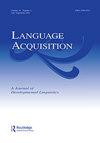中英双语者的英语衍生词识别:测试成分过程的性质和时间过程
IF 1.3
3区 文学
0 LANGUAGE & LINGUISTICS
引用次数: 0
摘要
利用形态启动的研究发现,二语说话者在衍生二语启动中表现出促进作用,这可能表明在衍生二语单词识别过程中存在形态加工。然而,第二语言衍生词识别的过程仍然知之甚少,一些人认为观察到的启动效应本质上可能不是形态学的。本研究部分复制了Rastle等人的研究,并将其扩展到二语英语加工。其目的是帮助我们理解二语衍生词识别的性质和时间进程。继Rastle等人之后,我采用视觉启动方法探讨了汉语-英语双语者在第二语言英语衍生词识别的后期中心词汇阶段中形态学、伪形态、正字法和语义过程的激活。研究结果与Rastle等人对母语为英语的人的研究结果一致。二语说话者表现出不同于形式重叠的形态效应,表明表面形式重叠不能解释衍生启动词对二语的促进作用。这些二语使用者进一步表现出与表面形式效应不同的伪形态促进作用,这表明在二语英语单词识别的后期阶段存在纯粹的词形正字法过程,并进一步表明二语对语素结构的敏感性不能用语义效应来解释。结果进一步表明,在英语的第二语言和第一语言人群中,形态、伪形态和形态机制的激活模式相似,并且在两种说话人群之间存在暂时转移。讨论了二语词识别理论的意义。感谢编辑和两位匿名审稿人的宝贵意见和建议。我还要感谢QRP2委员会的成员,Charlene Polio和Patti Spinner。利益竞争声明作者声明无利益竞争。补充信息本文的补充数据可在https://doi.org/10.1080/10489223.2023.2260792Disclosure网站上获取。声明作者未报告潜在的利益冲突。数据可用性声明数据可在https://osf.io/w8x72/?view_only=4c020c4469bf4f7dbcccd47cf0069291.Additional信息上获得资金本研究由密歇根州立大学SLS博士项目部分支持。本文章由计算机程序翻译,如有差异,请以英文原文为准。
English derived word recognition by Chinese‐English bilinguals: Testing the nature and time course of the component processes
ABSTRACTResearch utilizing morphological priming has found that L2 speakers show facilitation from derived L2 primes, which could suggest morphological processing during derived L2 word recognition. However, the process of L2 derived word recognition is still poorly understood, with some arguing that the observed priming effects may not be morphological in nature. The present study is a partial replication of Rastle et al. and its extension to L2 English processing. Its purpose is to contribute to our understanding of the nature and time course of L2 derived word recognition. Following Rastle et al., I employed visual priming methodology to explore the activation of morphological, pseudomorphological, orthographic, and semantic processes during a later, central-lexical stage of L2 English derived word recognition by Mandarin Chinese-English bilinguals. The results replicated Rastle et al.’s findings with L1 English speakers. The L2 speakers exhibited morphological effects distinguishable from effects of form overlap, suggesting that surface form overlap cannot explain L2 facilitation from derived primes. These same L2 speakers further showed pseudomorphological facilitation distinguishable from surface form effects, indicative of the operation of a purely morpho-orthographic process at the later stage of L2 English word recognition and further suggesting L2 sensitivity to morphemic structure that cannot be explained by semantic effects. Results further showed a similar graded pattern of activation of morphological, pseudomorphological, and form mechanisms in L2 and L1 speakers of English that appears to be temporally shifted between the two speaker populations. Implications for L2 word recognition theory are discussed. AcknowledgementsI am grateful to the editors and the two anonymous reviewers for their valuable comments and suggestions. I am also grateful to my QRP2 committee members, Charlene Polio and Patti Spinner.Competing interests declarationThe author declares no competing interests.Supplementary InformationSupplemental data for this article can be accessed online at https://doi.org/10.1080/10489223.2023.2260792Disclosure statementNo potential conflict of interest was reported by the authors.Data availability statementThe data are available at https://osf.io/w8x72/?view_only=4c020c4469bf4f7dbcccd47cf0069291.Additional informationFundingThis study was partially supported by the SLS Doctoral Program at Michigan State University.
求助全文
通过发布文献求助,成功后即可免费获取论文全文。
去求助
来源期刊

Language Acquisition
Multiple-
CiteScore
2.30
自引率
8.30%
发文量
20
期刊介绍:
The research published in Language Acquisition: A Journal of Developmental Linguistics makes a clear contribution to linguistic theory by increasing our understanding of how language is acquired. The journal focuses on the acquisition of syntax, semantics, phonology, and morphology, and considers theoretical, experimental, and computational perspectives. Coverage includes solutions to the logical problem of language acquisition, as it arises for particular grammatical proposals; discussion of acquisition data relevant to current linguistic questions; and perspectives derived from theory-driven studies of second language acquisition, language-impaired speakers, and other domains of cognition.
 求助内容:
求助内容: 应助结果提醒方式:
应助结果提醒方式:


